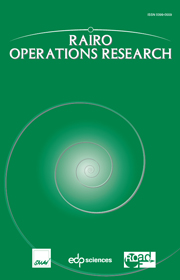Article contents
A Markov chain modelfor traffic equilibrium problems
Published online by Cambridge University Press: 15 April 2003
Abstract
We consider a stochastic approach in order to define an equilibrium model for a traffic-network problem. In particular, we assume a Markovian behaviour of the users in their movements throughout the zones of the traffic area. This assumption turns out to beeffective at least in the context of urban traffic, where, in general, the users tend to travel by choosing the path they find more convenient and not necessarily depending on thealready travelled part.The developed model is a homogeneous Markov chain, whosestationarydistributions (if any) characterize the equilibrium.
- Type
- Research Article
- Information
- Copyright
- © EDP Sciences, 2002
References
- 1
- Cited by


